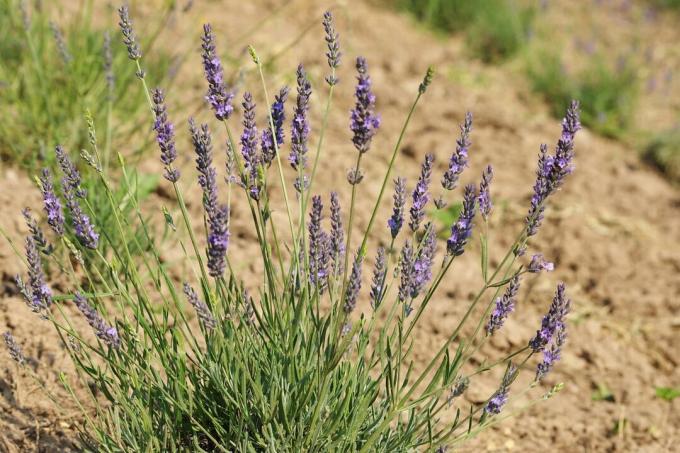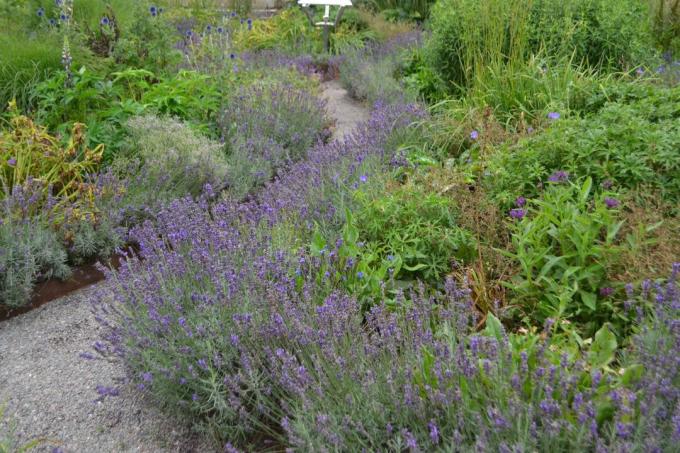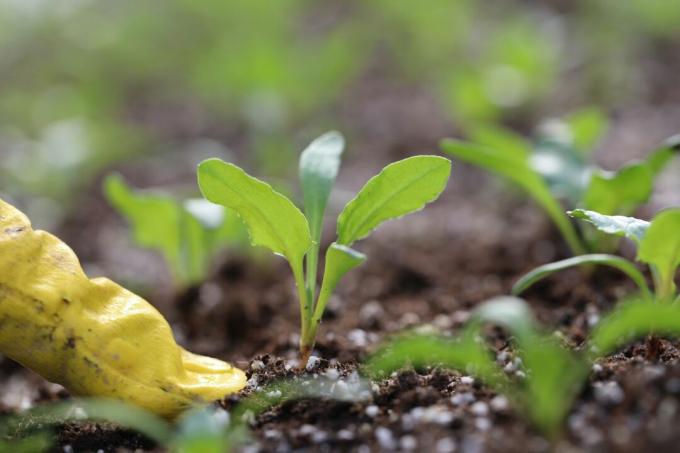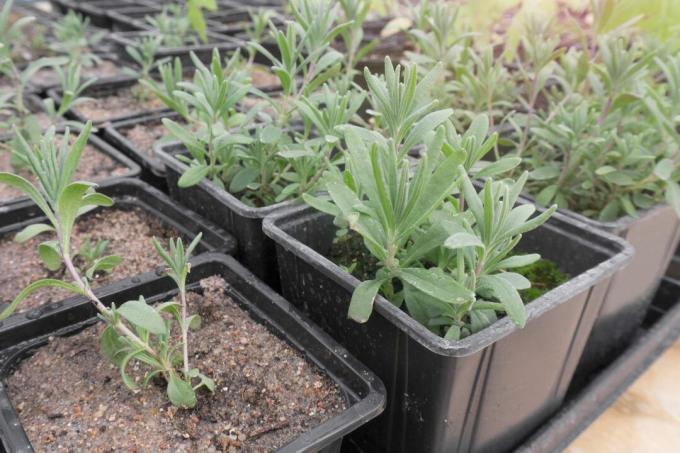The easy-care lavender not only impresses with its appearance and scent, but is also a real bee magnet.

Anyone who is interested in the scent and sight of the real lavender (Lavandula angustifolia) would like to please, simply plant the Mediterranean shrub in your own garden. the Care of lavender is not difficult and the buds are still quite impressive even when dried. In nature, lavender often grows on rocky slopes and poor soil. Here we show how you can find the right place for the lavender in the garden.
contents
- When should you plant lavender?
-
The right location for lavender
- Lavender in the garden
- The right soil for lavender
- sowing lavender
-
Instructions for planting
- How far apart do you plant lavender?
- Transplant lavender
- Good companion plants for lavender
When should you plant lavender?
It is best to plant lavender outside in spring. The ideal planting time for lavender is from mid-May, when no more frosts are to be expected. You can also plant the lavender from the end of March. Larger specimens can cope better with the weather - but in this case frost protection made of mulch material is recommended. If the water supply is secured, you can even plant the lavender in summer. Planting lavender in autumn, on the other hand, is not recommended - because then it hardly has time to grow properly before winter.

At a glance: When to plant lavender?
- Ideal: Spring from mid-May
- Possible: In summer when the water supply is guaranteed
- Frost protection is necessary depending on the planting time
The right location for lavender
It doesn't matter if you Lavender in the pot, in beds or even as Lavender Tree want to plant - the right location is crucial for a healthy and flowering plant. For the ideal lavender spot, look at the natural habitat of the pretty subshrub: it should be sunny, warm and rather dry. Lavender also likes nutrient-poor and calcareous soils.
Lavender in the garden
In the right location, lavender is a rather undemanding plant for the garden, which is also very popular with bees. It can be used as a tea herb or as a home remedy for clothes moths. In addition, one helps Lavender oil against fungus gnats. In addition to planting in the herb bed, the real lavender finds a place in the garden as a low scented hedge and bed edging. A planting distance of 20 - 40 cm should be maintained in the bed. Lavender can already make a magnificent picture on its own - but it is usually nicer to have three or five plants together.

Lavender as a bed border: There are numerous varieties of lavender. A lavender that stays rather small and grows compactly should therefore be chosen for the border of the bed. This includes, for example, the variety 'Blue Cushion'. The plants are placed in the prepared soil about 25 cm apart at the edge of the bed. There should not be more than three plants per meter to avoid competition. The small lavender hedge should be cut back regularly - because the lavender may not survive a cut back into the old, leafless wood.
The right soil for lavender
The lavender is dependent on a permeable soil. It prefers a soil that is nutrient-poor and calcareous. Lavender is not hardy on wet or even waterlogged surfaces. In very clayey soils, lavender can only be kept in the long term if the substrate in the planting area is generously exchanged for a permeable one. If the soil is a little too heavy for the lavender, it is a good idea to avoid waterlogging Garden soil from the planting hole to mix in a lot of sand and a drainage layer of pebbles to create. This creates the best possible starting conditions for planting. If there is no suitable soil, you can alternatively plant the lavender with a suitable substrate in a pot, raised bed or in a herb spiral.

sowing lavender
Even if it is a bit more complex, it can still make sense to sow the lavender. The roots develop in a natural way and the plant does not suffer a plant shock, as the young plants can adapt to the location - right from the start. As a result of the adaptation, sown specimens have a better chance of staying healthy for a long time than bought ones, even with advancing age. It is best to start a preculture on the windowsill, but direct sowing outdoors is also possible. The right conditions include sufficient warmth and light as well as the right soil. Lavender generally prefers a nutrient-poor substrate - such a substrate is particularly important for pre-cultivation. A suitable soil for the cultivation and for further culture is, for example, ours Plantura Organic Herb & Seed Soil, which intentionally has fewer nutrients and is particularly permeable. In addition, about a third of sand should be mixed in for better drainage. This creates ideal conditions for the lavender and its seeds. Lavender seeds are sown as follows:
- Stratify before sowing: refrigerate seeds for 2 – 4 weeks in a container with moistened sand. This treatment significantly increases the germination rate
- Growing on the windowsill from the beginning of March
- Afterwards, if possible, use indoor greenhouse
- Optimum germination temperature at 20 °C
- Pots with growing substrate like Plantura Organic Herb & Seed Soil prepare
- Distribute the seeds and press them down lightly
- Keep soil moderately moist
- Germination time 3 - 4 weeks
- Outdoor sowing possible between the end of April and the end of May
- Maintain a distance of 30 cm in the bed
What do lavender seedlings look like? After the appearance of the two small, rounded to spade-shaped cotyledons, the Lavender seedlings have the typical, elongated leaves that are somewhat reminiscent of conifer leaves and also that rosemary (Rosmarinus officinalis) look very similar.

Instructions for planting
Do you have the right one? Lavender variety and a suitable location selected or the seeds germinated, it is now time to plant the lavender. It should be mentioned again here that planting directly in the ground is only worthwhile if the soil and location are also suitable. If the subsoil is too clayey, the substrate must be replaced generously and, in extreme cases, up to 60% drainage material is mixed in. In this case, planting the lavender in a pot, in a heaped mound, in a raised bed or in a herb spiral is more promising. If the location and soil are right, then planting can begin. To do this, you should dig a sufficiently large planting hole from mid-May. This should be at least twice the size of the root ball of the purchased plant. If you have placed them in the middle of the planting hole, you can fill it up with soil. Since lavender originally comes from the rocky regions of the Mediterranean, its need for nutrients and water is rather low. The potting soil used should therefore be permeable and calcareous. Cultivation in one is also suitable for small gardens herbal spiral. Drought-loving plants - such as lavender - are best planted on the south or west side in the upper third of the spiral.
How far apart do you plant lavender?
So that the bushy lavender has enough space later on, you should not place the young plants too close together. A planting distance of about 30 - 40 cm is appropriate for lavender.

Transplant lavender
Basically, it is better to avoid transplanting the lavender, because it always means stress for the plant. Before the lavender dies in the wrong place, it is still advisable to move it to another place. Transplanting should also take place in spring, between the end of March and May, so that the lavender can take root in its new location before winter. Dig up the root ball generously in order to damage as little root system as possible.
Good companion plants for lavender
Lavender is combined with other plants to create a beautiful overall picture in the garden. The right choice must be made here so that the different species grow well next to each other. Due to the similar location requirements, it makes sense to mix the lavender with rosemary (Rosmarinus officinalis) to plant, with other Mediterranean herbs such as thyme (thymus) or sage (Salvia) are appropriate. You can plant mint and lavender together using a herb spiral. Here, however, the two herbs belong in different places. But which flowers go well with lavender? Suitable flowering companion plants for lavender are, for example, real sea kale (Crambe maritima), lady's mantle (Alchemilla), or Carthusian carnation (Dianthus carthusianorum).
Tip: On the other hand, the frequently mentioned roses (pink), as they prefer humus-rich, clayey and nutrient-rich soils.

At a glance: Which plants go well with lavender?
- Mediterranean herbs such as rosemary, thyme, oregano or sage
- Real sea kale
- lady's mantle
- Carthusian carnation
- Alyssum
If the lavender is now in your own garden, it is important to get it through the cold season well. We give tips on how to do it Overwinter lavender so that it blooms again next year.
